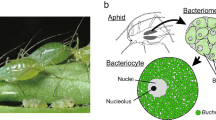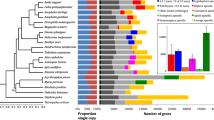Abstract
The ribosomal DNA arrays in the nucleolar organizer regions (NORs) of aphids are generally located in a telomeric or subtelomeric position on the X chromosomes. In aphid populations or species that have lost the sexual part of their life cycle and become permanent apomicts, multiple rDNA copies are often concentrated on only one of the original X chromosomes. This situation has been found in apomictic members of three aphid subfamilies, although not as yet in the tribe Aphidini, which includes several permanent apomicts that are important pests. Some clonal cultures ofAcyrthosiphon pisum andMyzus persicae reared for many years in conditions that prolong apomixis and inhibit sexual reproduction also have their rDNA arrays concentrated on one X chromosome. A 50-year-old clone ofAphis fabae, however, still retains a pair of similar-sized rDNA arrays on its X chromosomes. Although pairing of the X chromosomes by their NORs during prophase of the maturation division seems to be required for determination of XO males in aphids, a clone ofA. pisum with one rDNA array was nevertheless able to produce males when subjected to appropriate environmental conditions.
Similar content being viewed by others
References
Ault JG, Rieder CL (1994) Meiosis inDrosophila males. I. The question of separate conjunctive mechanisms for the XY and autosomal bivalents.Chromosoma 103: 352–356.
Black WC IV (1993) Variation in the ribosomal RNA cistron among host-adapted races of an aphid (Schizaphis graminium).Insect. Mol. Biol. 2: 59–69.
Blackman RL (1972) The inheritance of life-cycle differences inMyzus persicae (Sulz.) (Hem., Aphididae).Bull Entomol Res 62: 281–294.
Blackman RL (1975) Photoperiodic determination of the male and female sexual morphs ofMyzus persicae.J Insect Physiol 21: 435–453.
Blackman RL (1978) Early development of the parthenogenetic egg in three species of aphids (Homoptera: Aphididae).Int J Insect Morphol Embryol 7: 33–44.
Blackman RL (1980) Chromosome numbers in the Aphididae and their taxonomic significance.Syst Entomol 5: 7–25
Blackman RL (1988) Stability of a multiple X chromosome system and associated B chromosomes in birch aphids (Euceraphis sp.; Homoptera: Aphididae).Chromosoma 96: 318–324.
Blackman RL (1990) The chromosomes of Lachnidae.Acta Phytopathol Entomol Hung 25: 273–282.
Blackman RL, Hales DF (1986) Behaviour of the X chromosomes during growth and maturation of parthenogenetic eggs ofAmphorophora tuberculata (Homoptera, Aphididae) in relation to sex determination.Chromosoma 94: 59–64.
Blackman RL, Spence JM, Field LM Devonshire AL (1995) Chromosomal location of the amplified esterase genes conferring resistance to insecticides inMyzus persicae (Homoptera: Aphididae).Heredity 75: 297–302.
Fenton B, Birch ANE, Malloch G, Woodford JAT, Gonzalez C (1994) Molecular analysis of ribosomal DNA from the aphidAmphorophora idaei and an associated fungal organism.Insect Mol Biol 3: 183–189.
Hales, DF (1989) The chromosomes ofSchoutedenia lutea (Homoptera, Aphidoidea, Greenideinae), with an account of meiosis in the male.Chromosoma 98: 295–300.
Heslop-Harrison JS, Schwarzacher T, Anamthawat-Jonsson K et al. (1991)In situ hybridization with automated chromosome denaturation.Technique — a Journal of Methods in Cell and Molecular Biology 3: 109–116.
Kennedy JS, Booth CO (1951) Host alternation inAphis fabae Scop. I. Feeding preferences and fecundity in relation to the age and kind of leaves.Ann Appl Biol 38: 25–64.
King M (1988) The interrelationships of G-banding, C-banding pattern and nucleolus organiser structure in Anuran amphibians. In: Brandham PE, ed.Kew Chromosome Conference III. London: Her Majesty's Stationery Office, pp 51–63.
Kuznetsova VG, Gandrabur SI (1991) The nucleolar organizing regions in the aphid chromosomes.Tsitologiya 33: 41–47.
Lees AD (1990) Dual photoperiodic timers controlling sex and female morph determination in in the pea aphidAcyrthosiphon pisum.J Insect Physiol 36: 585–591.
McKee BD, Habera L, Vrana JA (1992) Evidence that intergenic spacer repeats ofDrosophila melanogaster rRNA genes function as X-Y pairing sites in male meiosis, and a general model for achiasmatic pairing.Genetics 132: 529–544.
Manicardi GC, Bizzaro D, Aloisi P, Bonvicini Pagliai AM, Bianchi U (1992) New approaches to the study of aphid chromosomes.Proceedings of the Fourth ECE/XIII, SIEEC, Godollo 1991. Budapest: Hungarian Natural History Museum, pp. 85–88.
Müller, FP (1988) Sympatric and allopatric variation in aphids.Zool Jb Syst 115: 129–142.
Procunier JD, Tartof KD (1978) A genetic locus havingtrans andcontiguous cis functions that control the disproportionate replication of ribosomal RNA genes inDrosophila melanogaster.Genetics 88: 67–79.
Rogers SO, Bendich, AJ (1987) Heritability and variability in ribosomal RNA genes ofVicia faba.Genetics 117: 285–295.
Roiha H, Miller JR, Woods LC, Glover DM (1981) Arrangements and rearrangements of sequences flanking the two types of rDNA insertion inDrosophila melanogaster.Nature 290: 749–753.
Schmid M (1982) Chromosome banding in Amphibia. VII. Analysis of the structure and variability of NORs in Anura.Chromosoma 87: 327–344.
Sen S, Khuda-Bukhsh AR (1992) Chromatid separation initiating from the NOR-bearing end of the metaphase chromosomes of two species ofAphis (Homoptera: Aphididae).Cytologia 57: 507–510.
Sutherland ORW (1969) The role of crowding in the production of winged forms by two strains of the pea aphid,Acyrthosiphon pisum.J Insect Physiol 15: 1385–1410.
Tartof KD (1974) Unequal mitotic sister chromatid exchange as the mechanism of ribosomal RNA gene magnification.Proc Natl Acad Sci USA 71: 1272–1276.
Van Emden HF (1988) The peach-potato aphidMyzus persicae (Sulzer) (Hemiptera: Aphididae) — more than a decade on a fully-defined chemical diet.Entomologist 107: 4–10.
White MJD (1973)Animal Cytology and Evolution, 3rd edn. Cambridge: Cambridge University Press.
Author information
Authors and Affiliations
Corresponding author
Additional information
accepted for publication by H. C. Macgregor
Rights and permissions
About this article
Cite this article
Blackman, R.L., Spence, J.M. Ribosomal DNA is frequently concentrated on only one X chromosome in permanently apomictic aphids, but this does not inhibit male determination. Chromosome Res 4, 314–320 (1996). https://doi.org/10.1007/BF02263684
Received:
Revised:
Accepted:
Issue Date:
DOI: https://doi.org/10.1007/BF02263684




